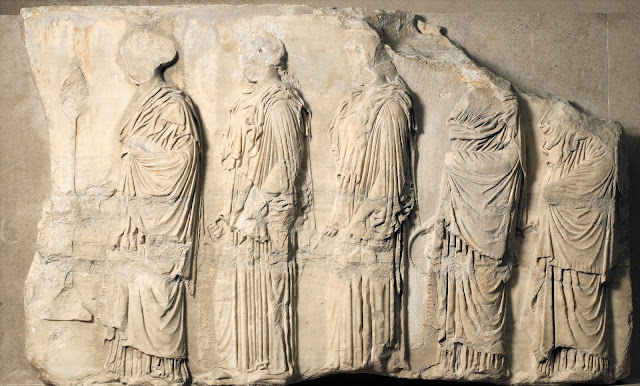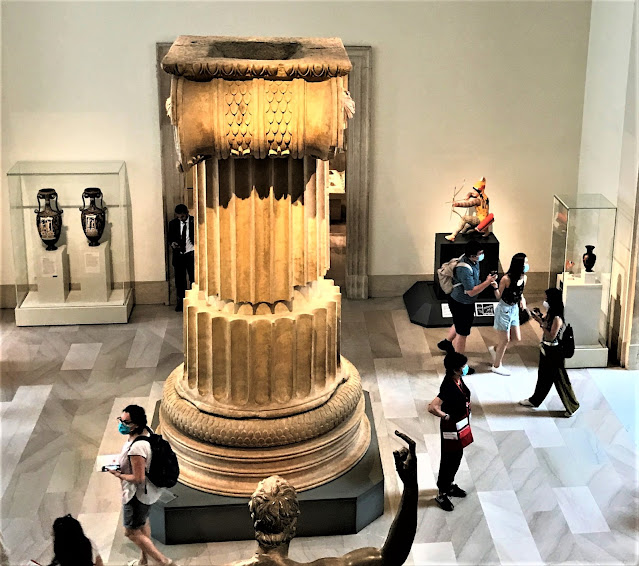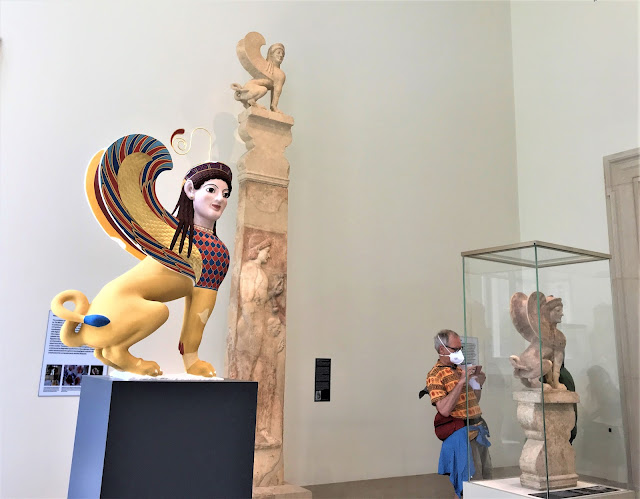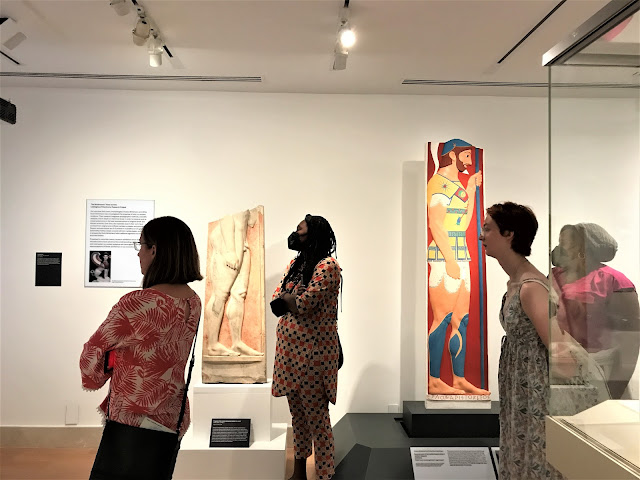.JPG) |
| Gallery view, showing the reduced scale reconstruction of the so-called Alexander Sarcophagus against the far wall |
Virtually all the civil and religious sculpture that was produced between the mid-15th century and the mid-20th century has been monochrome. It has been either white marble or bronze. Any visitor to the grand edifices built in those years in London or Paris or New York or Washington and any visit to the parks and plazas of those same cities (and countless others) knows this to be true.
Even statues of contemporaries or near contemporaries have been like this. Think of the statue of Queen Anne in front of London’s Saint Paul’s, of Louis XIV in the Place Vendome, of Queen Victoria in front of Buckingham Palace or of the monuments to Presidents Lincoln or Jefferson. The whiteness of the marble or the tone of the bronze have come to signify their greatness, their eternal fame and our own sense of memory.
This sensibility was handed down to our ancestors by their ancestors, going all the way back to the Renaissance, when the first archaeological excavations unearthed survivors of the classical Greek and Roman past and those survivors were white or bronze. Or were they?
 |
| Pheidias, Procession of women from the Parthenon Frieze, Athens Greek, c. 438-432 BC London, Trustees of the British Museum This has for long been the accepted standard of classical sculpture. |
Since most of the unearthed marble statues from antiquity were made of marble from the island of Paros, they came to be known as Parian marble.1 Looking back through the years the word “parian” has always conveyed an impression of gleaming but remote and perfect whiteness. Much effort was made in the 19th century to recreate this exquisite material in cheaper, more abundant materials, perfect for the diffusion of classical taste to the wider public. This was achieved by the discovery in Europe of the process of making hard paste porcelain, first in France, with the glorious Sevres porcelain, but later in England and Ireland. Josiah Wedgwood became famous and rich for producing pottery distinguished by pure white figures fired onto vessels of various colors, especially the light “Wedgwood” blue which he made famous. The Beleek company in Northern Ireland has always been proud of the pure white “Parian ware” produced from its kilns.2 In other words, “parian” represented an imagined, ideal classical past.
 |
| Josiah Wedgwood and Sons, Vase English, c. 1790 London, Victoria and Albert Museum |
However, while this may be the impression that is shared by the general public, art historians know that this has almost always been an illusion, that the classical past was as colorful, perhaps even more colorful, than the present. We knew that many ancient statues showed traces of eroded pigments, often held in protected areas like folds, but occasionally easily visible to the naked eye. We knew that medieval artists continued using color on statues, both in stone and in wooden statues. We could see it, sometimes blatantly obvious, sometimes more hidden. If one looked closely enough, it was there to be seen. But this has remained an “insider” view, not one shared by the general population. Until now.
In the last few years, a traveling exhibition that set out
to change that general opinion has been visiting major museums around the world
and it is now the turn of the Metropolitan.
Indeed, the Met itself has been a major participant in producing this
particular show, using its extensive collection and the advanced techniques for
analyzing the remains of ancient pigments that its conservation
department affords. Since the exhibition,
called “Chroma: Ancient Sculpture in Color”, was first announced I have been
itching with anticipation to see it. A couple of days ago I did, and it was a very
satisfying experience, which will have to be repeated multiple times.
 |
| Gallery view showing the reconstructed figure of an Archer from the Temple of Aphaia at Aegina (in the spotlight) among objects from the Metropolitan's own collection |
At first, I was a bit taken aback by the way in which the
exhibition is organized. I had expected
to find the objects in question in one of the special exhibition galleries, all
in one place, as is usual. However, they
are not arranged in this way. In keeping
with a recent philosophical change regarding exhibitions, the objects in this
exhibition are scattered throughout the Greek and Roman galleries, turning the
act of viewing them into something of a treasure hunt. But, in most cases, they aren’t hard to
find. Unfortunately, I had slept badly
the night before and so was very tired, causing my ailing back and shoulder to
be more painful than usual. So, this
limited the energy and the patience I had available for a hunt. I will have to return (probably several
times) to see it all.
As you might suspect from the title of this essay and from
this preamble, the subject of this exhibition is a little unusual. It is an exploration of the use of color in
antiquity. Much to the surprise of the
multitudes who have assumed for centuries that “classical” Greek statues were
carved and displayed in a kind of pure, pearly white, state, indicative of a
society that was idealizing, calm and unflappable, these statues were
originally highly, even (to our eyes) garishly, colored. Thus, the “ideal” marble statues of the Renaissance
and later, from Michelangelo’s David through Bernini’s Apollo and Daphne to
Canova’s Perseus to the Lincoln Memorial, are based on a misunderstanding of
the evidence from antiquity. Instead,
the ancient Greeks and Romans used lifelike color and gilding to create works
that, at the time looked astonishingly lifelike.3 If the crowds gathered around these works are any indication, some of them are catching modern people up
short.
The exhibition includes works from the Archaic Greek period
through the Roman period, or roughly for about 700 years. Colored reconstructions of ancient works from
the Met’s collection are displayed alongside the originals throughout the Greek
and Roman galleries. Some of the colorized works represent originals not from
the Met’s own collection, but these are displayed beside related items that do
belong to the museum. The coloration of the reproduced works is based on
careful, scientific analysis of the traces of pigment that can still be found
on them. The work of analysis has largely
been driven by Dr. Vincenz Brinkmann, a professor of Archaeology and curator of
the Collections of Antiquities and Asia at the Liebighaus Museum of Sculpture
in Frankfut-am-Main, with the help of scientists and conservation professionals
in many museums and universities. The work of applying the colors has been accomplished by his wife, Ulrike Koch-Brinckmann, who is an art historian specializing
in antiquity.
 |
| Gallery view showing the original funeral stele against the wall, the original Sphinx finial on the right and the reconstructed, painted Sphinx on the left. |
Seeing these surprisingly colorful images, next to the original or closely related original works, is astonishing. Suddenly, those fragile, nearly hidden colors become bold and alive! Among the most striking of the objects I saw was the image of a sphinx, directly modeled from a well-known Met original, the finial atop the funerary stele of a young man from the mid-fifth century BC.
 |
| Marble Capital and Finial in the Form of a Sphinx Greek, c. 530 BC New York, Metropolitan Museum of Art One can see the remains of paint on the marble original with the naked eye. |
The colorized sphinx is set up next to the original, and behind it one can see the stele that the original once adorned (the crowning sphinx finial now replaced with a molded copy). They make a startling grouping. And, now that color is being underscored, one can see that the stele itself was once highly colored. The upper area, including the young man’s head and the background behind it, were once highly colored. Traces of pigment are clearly visible in his hair, eyebrows, eyes and the background surrounding his upper torso.
.jpg) |
| Marble Stele with a Youth and Little Girl Greek, c. 530 BC New York, Metropolitan Museum of Art |
Similarly, on the mezzanine level of the Greek and Roman galleries, usually a very lightly visited area, a group of people were transfixed by a video describing how the process of unraveling the colors and recreating the past was accomplished, while standing next to a stele dedicated to a Hoplite (foot soldier) and a copy of a similar stele that has been colorized.
 |
| Gallery View Showing Visitors Standing Beside the Met's Image of a Hoplite and the Reconstruction of a Similar Image while watching an explanatory video. You can view the same video at Chasing Color |
That upper area also included some other gems. There is a comparison of a colorized statuette of a Kore (young woman), next to a full sized original from the Met’s collection and a case filled with small works from the Met’s collection that contain significant traces of paint.
 |
| Case containing smaller items in terracotta from the Hellenistic and Roman periods. All have retained vestiges of their original color. |
 |
| Terracotta Statuette of a Woman Greek-South Italian, Late 3rd Century BC New York, Metropolitan Museum of Art This is the statuette that is farthest to the left in the picture above. |
At the very entrance of the Greek and Roman galleries stands
the funerary statue of a Kore (young woman).
She looks like many of the Kore that are included in collections from
around the world, but she is painted and gilded. From her astonishingly patterned red dress to
her black hair, from her gold-tinged sandals, belt, necklace and bracelets to
the bud she holds in her left hand to the crown of similar buds on her head,
she is a presence, an individuated presence.
 | |
Reconstruction of Kore from the funerary Stele of Phrasikleia Greek, c. 540 BC, Athens, National Archaeological Museum Colorized reproduction © Vincenz Brinckmann, 2010 |
Farther along the main Greek and Roman sculpture gallery stands another woman who might almost be one of us. Indeed, as I approached her, a woman wearing a sari passed her by and I was struck by how similar the clothing was, in a way I would never have imagined if that sari clad woman had passed by a typical looking Roman statue. It simply would not have occurred to me that the folds of the two dresses from different parts of the globe and from a distance of almost two thousand years fell in the same ways. This statue is also set next to an original from the Met collection.
 |
| Reconstruction of a Marble Statue, so-called Small Herculaneum Woman Greek, Second Century AD Athens, National Archaeological Museum Colorized reproduction © Vincenz Brinckmann, 2019 |
I found this statue a bit unnerving. Some of the others are done in very strong colors, but the research on this one has shown that the colors used were softer and more subtle. Therefore, she has a more contemporary feel and a truly eery lifelikeness that was a bit unnerving. She certainly attracted many visitors.
There are quite a few objects in this exhibition, including portrait busts, bronze warriors, reconstructions of works from temple pediments and other items. It was more than I could encompass in a few hours with little sleep and in a good deal of pain. I will be getting back there soon and will continue to edit this article as I do. I thought about waiting to publish this until I had seen more of it, but decided that this approach is better. I urge anyone who can get there between now and next March to do so. The exhibition will be in place until March 26, 2023.
© M. Duffy, 2022
1)
Merriam-Webster
definition:
1.
a porcelain composed essentially of kaolin and
feldspar and usually used unglazed in ornamental articles
2.
of or relating to the island of Paros noted for
its marble used extensively for sculpture in ancient times
“Parian.” Merriam-Webster.com Dictionary, Merriam-Webster,https://www.merriam-webster.com. Accessed 16 Jul. 2022.
Parian Ware:
2) Parian ware, porcelain introduced about 1840 by the English firm of Copeland & Garrett, in imitation of Sèvres biscuit (fired but unglazed porcelain). Its name is derived from its resemblance to Parian marble.
"Parian ware". From Encyclopedia Britannica, 14 Mar. 2008, https://www.britannica.com/art/Parian-ware. Accessed 16 July 2022.
3)
A good discussion of this issue is found at https://buntegoetter.liebieghaus.de/en/


1 comment:
These pictures are astonishing. I hope I can organize myself to get there, certainly more than once. Grazie mille for sharing this.
Post a Comment